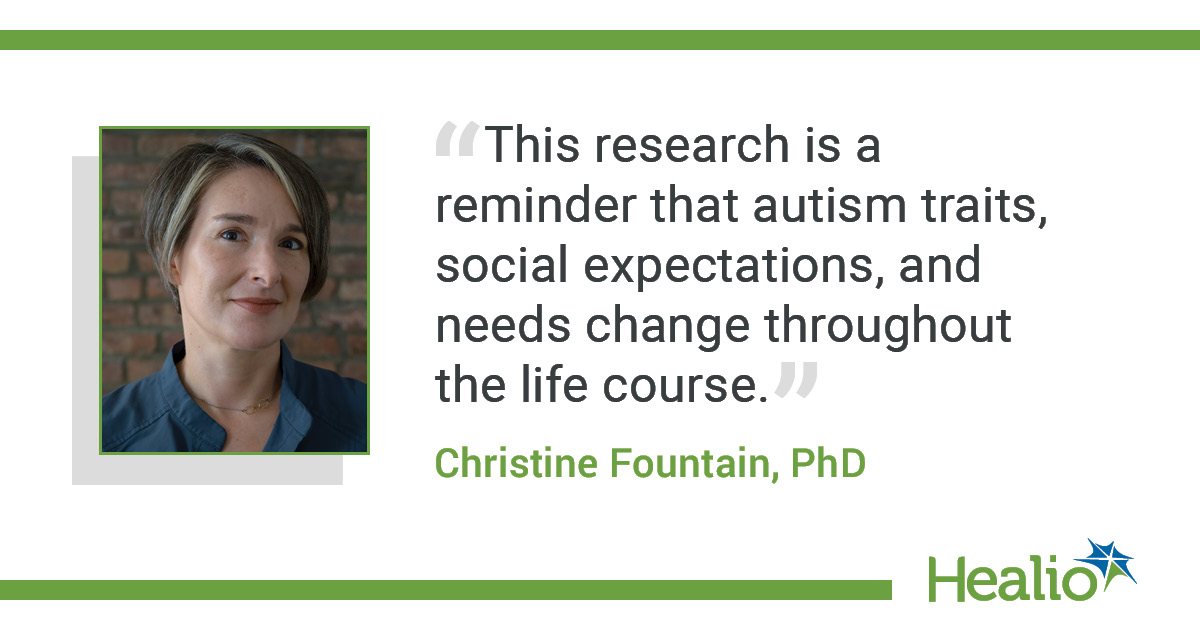ADD TOPIC TO EMAIL ALERTS
ADDED TO EMAIL ALERTS
Key takeaways:
A study of children with autism found that most demonstrated improved communication and social interaction as they aged, but some experienced a rapid decline in social functioning during adolescence.
The decline was associated with socioeconomic factors, race and ethnicity, “indicating that unequal access to resources contributes to disparities in individuals’ experiences,” researchers wrote in Pediatrics.
Earlier this year, data in MMWR indicated that the prevalence of autism among 8-year-old children in the United States has increased to one in 36, and other reports have also signaled a rise in diagnoses among children and teenagers.
“The long-term trajectories of persons with autism are still poorly understood,” Christine Fountain, PhD, an associate professor of sociology at Fordham University, told Healio.
“My colleagues and I conducted some related research several years ago where we looked at the longitudinal trajectories of children with autism in California and found fascinating results but were only able to follow them through age 14,” Fountain said. “When we obtained updated data on these cohorts through adolescence and into adulthood, it was an opportunity to find out what the long-term trajectories looked like with unprecedentedly long and frequent follow-up.”
Fountain and colleagues used data from the California Department of Developmental Services — “the largest available database with the longest follow-up of autistic persons,” according to them” — to find six typical trajectories for communication skills and seven trajectories for social skills.
“We then look at the characteristics of people in each of these groups, and assess the factors — including individual, family, and neighborhood characteristics — that are associated with being in each trajectory group,” Fountain said.
After removing subjects with four or fewer evaluations in the database, the authors had a sample of 71,285 individuals born from 1992 through 2016.
“In order to assess service needs, every year they evaluate each person on their caseload, and [these are the data] we analyze,” Fountain said. “For each person with autism in California, we create sequences of their annual social and communication skill evaluations. Then we pool together these sequences, on more than 70,000 individuals from diagnosis until up to age 27 for the oldest, and find the most ‘typical’ trajectory curves.”
According to the results, living in a high-inequality zip code was associated with autism disorders (OR = 1.14; 95% CI, 1.04-1.27), with each mean increase in median home value associated with decreased odds of autism by about 11% (OR = 0.89; 95% CI, 0.84-0.93) and a low density zip code associated with a 16% increase in odds for autism (OR = 1.16; 95% CI, 1.04-1.29).
Although the authors found a significant amount of diversity in their population, which Fountain said was “unsurprising” considering their past research, they were “surprised to find a small group” — 5% of the participants — “whose social evaluations declined precipitously right around puberty.”
Inclusion in this group was associated with “maternal non-Hispanic white race and ethnicity, female sex, moderate levels of maternal education, lower zip code-level median home values and population density, and higher zip code-level inequality,” the authors wrote.
“This was surprising because we hadn’t seen a hint of it in our previous study, which stopped right at the point of this decline,” Fountain said. “It was also surprising because its correlates don’t follow a clear story of socioeconomic advantage or disadvantage, the way some of the other trajectory patterns do. These children are slightly more likely to be girls, especially non-Hispanic white girls from middle/working class families. We don’t completely understand the processes that produce this adolescent decline group, so it is a question we will study further.”
The authors also reported other findings that Fountain called “unsurprising but disappointing.”
“Children from families with more socioeconomic resources — as indicated by maternal education, private health insurance, and living in zip codes with higher median home values — tend to improve more and at a faster pace, especially in their communication skills,” Fountain said. “We found similar patterns in our research conducted more than 10 years ago, and unfortunately it seems these disparities have persisted.”
She said further research is needed to understand the significant socioeconomic and ethnic disparities related to these trajectories, as well as why adolescent decline is more common among girls.
“This research is a reminder that autism traits, social expectations, and needs change throughout the life course,” Fountain said. “Adolescence can be a time during which autistic children may benefit from additional support.”
Read more about
ADDED TO EMAIL ALERTS
This content was originally published here.
